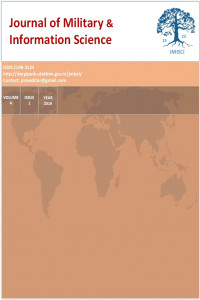Öz
SMEs should organize alliances with universities or other research organizations, global business companies, and other SMEs. Each type of alliance has specific risk and success criteria to be studied. SMEs need to construct successful alliances in order to have sustainable business in a competitive environment. Pre-analysis of the path for successful alliances will lead to improvements in innovative power. This study attempts to perform qualitative analysis of the SME alliances in order to express the criteria supporting the success in innovation. In this empirical study, the survey results will be extracted by literature taxonomy to categorize criteria of innovation success. These results will be analyzed by the Analytic Hierarchy Process to prioritize the innovation criteria to help any SME or large business to reduce risks in future alliances. This study will allow structuring strategic decisions based on operational criteria.
Anahtar Kelimeler
Kaynakça
- Álvarez, M., Moreno, A., & Mataix, C. (2013). The analytic hierarchy process to support decision-making processes in infrastructure projects with social impact.Total Quality Management & Business Excellence, 24(5-6), 596-606.
- Block, F., & Keller, M. R. (2009). Where do innovations come from? Transformations in the US economy, 1970–2006. Socio-Economic Review,7(3), 459-483.
- Bozbura, F. T., Beskese, A., & Kahraman, C. (2007). Prioritization of human capital measurement indicators using fuzzy AHP. Expert Systems with Applications, 32(4), 1100-1112.
- Cooper, H. M. (1982). Scientific guidelines for conducting integrative research reviews. Review of educational research, 52(2), 291-302.
- De Jong, J. P., & Marsili, O. (2006). The fruit flies of innovations: A taxonomy of innovative small firms. Research policy, 35(2), 213-229.
- Feng, B., Ma, J., & Fan, Z. P. (2011). An integrated method for collaborative R&D project selection: Supporting innovative research teams. Expert Systems with Applications, 38(5), 5532-5543.
- Hughes, A., & Wood, E. (2000). Rethinking innovation comparisons between manufacturing and services: the experience of the CBR SME surveys in the UK (pp. 105-124). Springer US.
- McLeod, S. (2008). Likert Scale, http://www.simplypsychology.org/likert-scale.html, Latest Access Time for the website is 20 October 2015.
- Poggel, C., & Schönwetter, G. (2010). Analyzing differences in the logistics competence between small and medium enterprises (SMEs) and large companıes–An empirical study. Proceedings of the 2nd ICLT, Christchurch, New Zealand,
- Saaty T.L., (1980) The Analytic Hierarchy Process, McGraw-Hill, NY.
- Saaty, T.L., & Vargas, L. G. (1994). Decision making in economic, political, social, and technological environments with the analytic hierarchy process (Vol. 7). Rws Pubns.
- Singh, R. K., Garg, S. K., & Deshmukh, S. G. (2008). Strategy development by SMEs for competitiveness: a review. Benchmarking: An International Journal,15(5), 525-547.
- Taha, H.A., (2003).Operation Research and Introduction. 7th edition. NewJersey: Prentice Hall.
- Yoon, K. P., & Hwang, C. L. (1995). Multiple attribute decision making: an introduction (Vol. 104). Sage publications.
Öz
Kaynakça
- Álvarez, M., Moreno, A., & Mataix, C. (2013). The analytic hierarchy process to support decision-making processes in infrastructure projects with social impact.Total Quality Management & Business Excellence, 24(5-6), 596-606.
- Block, F., & Keller, M. R. (2009). Where do innovations come from? Transformations in the US economy, 1970–2006. Socio-Economic Review,7(3), 459-483.
- Bozbura, F. T., Beskese, A., & Kahraman, C. (2007). Prioritization of human capital measurement indicators using fuzzy AHP. Expert Systems with Applications, 32(4), 1100-1112.
- Cooper, H. M. (1982). Scientific guidelines for conducting integrative research reviews. Review of educational research, 52(2), 291-302.
- De Jong, J. P., & Marsili, O. (2006). The fruit flies of innovations: A taxonomy of innovative small firms. Research policy, 35(2), 213-229.
- Feng, B., Ma, J., & Fan, Z. P. (2011). An integrated method for collaborative R&D project selection: Supporting innovative research teams. Expert Systems with Applications, 38(5), 5532-5543.
- Hughes, A., & Wood, E. (2000). Rethinking innovation comparisons between manufacturing and services: the experience of the CBR SME surveys in the UK (pp. 105-124). Springer US.
- McLeod, S. (2008). Likert Scale, http://www.simplypsychology.org/likert-scale.html, Latest Access Time for the website is 20 October 2015.
- Poggel, C., & Schönwetter, G. (2010). Analyzing differences in the logistics competence between small and medium enterprises (SMEs) and large companıes–An empirical study. Proceedings of the 2nd ICLT, Christchurch, New Zealand,
- Saaty T.L., (1980) The Analytic Hierarchy Process, McGraw-Hill, NY.
- Saaty, T.L., & Vargas, L. G. (1994). Decision making in economic, political, social, and technological environments with the analytic hierarchy process (Vol. 7). Rws Pubns.
- Singh, R. K., Garg, S. K., & Deshmukh, S. G. (2008). Strategy development by SMEs for competitiveness: a review. Benchmarking: An International Journal,15(5), 525-547.
- Taha, H.A., (2003).Operation Research and Introduction. 7th edition. NewJersey: Prentice Hall.
- Yoon, K. P., & Hwang, C. L. (1995). Multiple attribute decision making: an introduction (Vol. 104). Sage publications.
Ayrıntılar
| Birincil Dil | İngilizce |
|---|---|
| Bölüm | Articles |
| Yazarlar | |
| Yayımlanma Tarihi | 16 Ocak 2016 |
| Yayımlandığı Sayı | Yıl 2016 Cilt: 4 Sayı: 1 |


